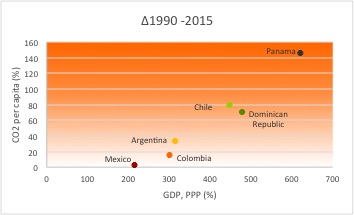[This guest blog post is authored by Dr. Sperling, an ‘Urban Futures and Energy-X Nexus’ engineer and multi-disciplinary researcher at the National Renewable Energy Lab in Colorado. He supports the cities/subnational integration working groups in the Low-Emissions Development Strategies Global Partnership (LEDS-GP).]
In recent collaboration with the ‘Subnational Integration Working Group’ of the Low Emissions Development Strategies Global Partnership (LEDS GP), I co-authored a report, titled: ‘Forging low emission development paths in Latin America & the Caribbean: Multilevel dynamics in the world’s most urbanized region.’ In the report, we present an overview on the state of low emission development and multi-level governance in the region, and compare country performances on key metrics (see LEDS-GP Data Explorer). This work helps enable low emission urbanization and infrastructure transitions. It explains the drivers and barriers to achieving and monitoring nationally determined contributions (NDCs) for climate action, while capturing unique lessons from the region. This post highlights key insights from the report.
Urbanization, Multi-Level Governance, and Subnational Integration to Unlock Transitions
Today, Latin America and the Caribbean (LAC) is the most urbanized region in the world, with 80% of the population living in cities—503 million people in cities, marked increase from 314 million in 1990.

Energy and Infrastructure: Just Transitions
In recent decades, economic growth has been strong in Latin America, yet this growth has not benefited all populations. The case of Chile offers a story of growth linked with increased energy demand, met by a doubling of electricity production from coal resources between 2000 and 2010, which resulted in urban air pollution challenges. To address this issue, in September 2014 the Municipality of Santiago, in partnership with the National Ministry of Environment and the Ministry of Transportation, registered the first transport-based Nationally Appropriate Mitigation Action (NAMA) with the UNFCCC. This case-study highlights the potential for increased coordination of national and local levels on climate action. The enablers and barriers to energy and infrastructure transitions are described in greater detail in the full report.
Positive trends of economic growth with decoupling of CO2 from GDP, with relatively small increases in CO2/capita do exist in LAC (e.g. Mexico, Colombia). However, significant room for improvement remains in accelerating and enabling the decoupling of emissions from economic growth. To date, increases in GDP and decreasing carbon intensities do not represent necessary emissions reduction below critical ceilings and climate safety thresholds. It can be misleading to celebrate falling carbon intensities while CO2 emissions continue to increase. For example, while the carbon intensity of the economies in Chile and Panama decreased impressively between 1990–2015 (by –56% and –45%, respectively), their annual CO2 emissions from fossil fuels and cement have skyrocketed by +143% and +295%.

If the economic growth trends in Chile (a 448% increase in GDP associated with a 79% increase in CO2/capita) unfolded globally, we would fail to maintain global average temperature change below 1.5–2.0°C. New ambitious action plans on energy and infrastructure, through improved multi-level governance on climate actions and LEDS are critical.
City-Driven LEDS for Economic-Environmental-Social Prosperity
While large metro areas and capital cities represent >50% of GDP in the LAC region, the role of small to mid-sized cities is also significant. Fifty percent of the urban population in LAC is living in cities with fewer than 100,000 inhabitants. Therefore, multi-level governance, improved data sharing, and cooperative planning for the subnational implementation of LEDS across all types of cities is needed.
The following five points are a triple-bottom line approach to enable multi-level governance of LEDS:
- Learning from low-emission urbanization within the context of diverse city priorities across LAC.
- Infrastructure and energy system transitions that help avoid emissions ‘lock-in’ via local-regional-state-to national coordination, cross-sector collaboration and public/private partnerships.
- Institutional capacity for responding to local needs and national-to-global climate targets, that align with environmental, economic, and equity goals of sustainability.
- Sustainable-smart-resilient infrastructure development can deliver important co-benefits (e.g. improved air quality, disaster risk reduction, social equity) and help link local-to-national priorities.
- Integrated data, visualizations and analytics will enable more effective monitoring, LEDS priority-setting, and strategic diffusion of critical technologies, plans, policies, behaviors, and financing.
These five pragmatic strategies can inform aggressive action plans and new policies towards low-emission urbanization, infrastructure and energy transitions in the LAC region and beyond.
Membership in the LEDS GP is open to organizations, individuals and governments working to promote LEDS at the local, national, regional and global level. It is easy to join LEDS GP and there is no cost to become a member. Follow this link for more information.

Comments